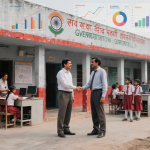- December 9, 2023
- by Educational Initiatives
- Blog
- 0 Comments

Education technology has seen greater adoption than ever before catalysed by the outbreak of the COVID-19 pandemic. Teachers are recording lessons, sharing inputs over phone calls, states are using TV networks, there is use of community radios and many other innovations. Personalised digital learning has seen a surge among households that have access to smartphones and Internet. The recent ASER survey validated this trend with over ~75% of students surveyed receiving learning support at homes. Within the next one year, in order to #BuildBackBetter, technology will play an important role in ensuring availability of data to educators and policymakers, as well as, reduce the effects of school closures on learning loss.
We asked our guests of EI Dialogues on what they thought were the post-pandemic opportunities in education and what was their best piece of advice on how to make it happen. One of the themes that emerged was the opportunity to unlock the potential of EdTech and build digital infrastructure.
Ashok Kamath, Akshara Foundation
The global pandemic has resulted in a huge disruption of the academic system. Children in rural communities, who go to the government primary schools, are definitely the worst hit. Governments are faced with the double challenge of a) physical training of teachers where social distancing will be an issue and b) keeping children engaged and learning until the situation gets better.
One big barrier stands in the way of making any of the above alternate learning programmes a reality – Digital Infrastructure. Much of India’s ‘EdTech’ sector has been restricted to innovations for urban schools. It’s time to ‘Build Back Better’. We need to bridge this divide by providing equal access to every single child. Fortunately, as a country, we have made some critical investments. The Ministry of Education (formerly MHRD) has made investments in setting up the Diksha platform with the help of EkStep Foundation. Now the problem to solve how to get a smartphone in the hands of every child for at least half the week?
If that is sorted, an alternate learning project with half the children of a class in the classroom (learning from the teacher) and the other half at home (practicing on these said devices) could be the best way to leverage this digital infra.
This alternating will ensure that (i) children attend classes for half the week, (ii) children get the benefit of the teacher in-person for at least half the week, (iii) the digital divide problem is mitigated, (iv) the system leverages existing technology and capabilities by implementing new processes, and (v) since children have devices we can even build in an improved system of continuous assessment using the principles of formative assessment.

Watch EI Dialogues with Ashok Kamath to know more about scaling effective interventions, especially relevant for programs that are piloting during COVID-19: https://youtu.be/H8X4t0Gamk8
Sourav Banerjee, Room to Read
With the outbreak of the COVID-19 pandemic, schools shut down across the country and the education system was left stranded. In the next few months, it was heartening to see schools, both private and government, trying to reach out to the children to maintain education continuity. With support from various organizations, both for-profit and non-profit, a variety of EdTech content was rolled out. These contents, which targeted children, teachers, and even parents, were disseminated through a variety of means including digital platforms, WhatsApp and Telegram, IVR and telephones, television, radio, and community radio. While the jury is still out on what percentage of children had access to these contents and whether the EdTech content helped in children’s learning, a couple of positive things emerged from these efforts.
One, there was an all-round acceptance of EdTech and its importance in reaching out to key education constituents (children, teachers, parents) in times of distress. Education officials, who were hitherto skeptical about tech-based content, saw the value of these in absence of classroom lessons. While for many parents, the effort till now was to keep children away from screens, suddenly everyone was dependent on the screens – TV, laptop, desktop, and mobile. Although the content available was not all of great quality, but there was enough good quality content. Going forward, this presents an enormous opportunity for the education system; to harness these EdTech solutions post-COVID-19 to supplement classroom-based teaching. Good quality blended learning looks like a possibility in the years to come. For effective use of technology, the challenge of the digital divide will, however, need to be addressed and all children will need to be provided access to technology, both a device and good connectivity.
The second positive spin-off of the pandemic has been the parents’ engagement in their children’s learning. For months, as most parents remained confined to their homes and the children kept exploring various distant means to keep in touch with their education, parents found themselves getting involved in their children’s learning process. Whether it is an urban parent trying to fix their child’s zoom settings or a rural parent listening to a story over the phone along with their children, parents’ efforts to support their children was notable across the economic spectrum. If this trend continues post-COVID-19, it would be a very welcome change as for years the education system has struggled to get parents involved in their children’s education. The process of parent engagement can, however, be made more structured/organized by providing parents with specific guidance through their phones, or other online means.
A third benefit emerging out of the pandemic is the openness of teachers to be trained through a virtual medium. Virtual training offers immense possibilities; teachers can be exposed to well-known experts and state-of-the-art research and practices through online platforms. At the same time, such trainings are less costly than face-to-face trainings, and also do not require the teachers to be pulled out from their classrooms. Till now, teachers were generally reluctant to undergo virtual trainings and participation was limited. However, with most governments/school systems making such trainings mandatory during the pandemic, it can be hoped that teachers’ mindset regarding such trainings would change.

Watch EI Dialogues with Sourav Banerjee to get a bird’s eye view of the evolution of the Indian education landscape and learn about scale-up pathways for programs: https://youtu.be/RDbJVCNO_cg
Sridhar Rajagopalan, Educational Initiatives
The pandemic has served as a reset and has challenged our traditional ways of doing things. This is the biggest opportunity it has afforded. Research shows that a ‘forced experimentation’ (for example, if a daily route is blocked due to construction) causes many people to stick to the altered method, which was available but had not been tried earlier. The outbreak of the COVID-19 pandemic was a forced experiment in education across the world.
The openness to digital tools has increased and teaching models will become more hybrid – this change in mindset must be built through mechanisms to certify educational content and processes with a focus on quality and evidence of improving learning outcomes. But more importantly, the COVID-19 pandemic has given us a chance to address underlying issues like rote learning, lack of systemic capacity, lack of regular low-stakes assessment, and inequities in digital access in our system. We must use this opportunity to eliminate those problems.

Watch EI Dialogues with Sridhar Rajagopalan to learn more about how underlying issues like rote learning can be tackled: https://youtu.be/K3M-e0FS8VE
The current situation demands personalized adaptive self-learning software that benefits students as they remain physically away from their teachers and have different learning levels. Continuous student assessment aids students to learn through practice, explanations and feedback directly on the platform. Making such a platform available to children will ensure that children are engaged and gain proficiency in foundational skills of Language and Math. Educational Initiatives’ built Mindspark to enable children to learn with conceptual clarity. It is interactive and dynamically customizes the content being delivered to match the level and rate of progress made by each student. Mindspark is available online via browser as well as an app in English and 8 Indian languages: Hindi, Marathi, Gujarati, Telugu, Kannada, Tamil, Urdu, and Punjabi for Grades 1 to 9 for Math, Language and English as a Second Language with its content mapped to the National Curriculum Framework.
Footnote:
These write-ups are sent to us by our guests on EI Dialogues. EI Dialogues is a video series centred around initiating and furthering dialogues around impacting development in education at scale. Dialogues attempt to synthesize perspectives around education reforms, technology for social impact, and systemic transformation by speaking to individuals from varied roles working to improve education in India.
All episodes can be found on www.youtube.com/eivideos and Spotify, Apple, and Google Podcasts



